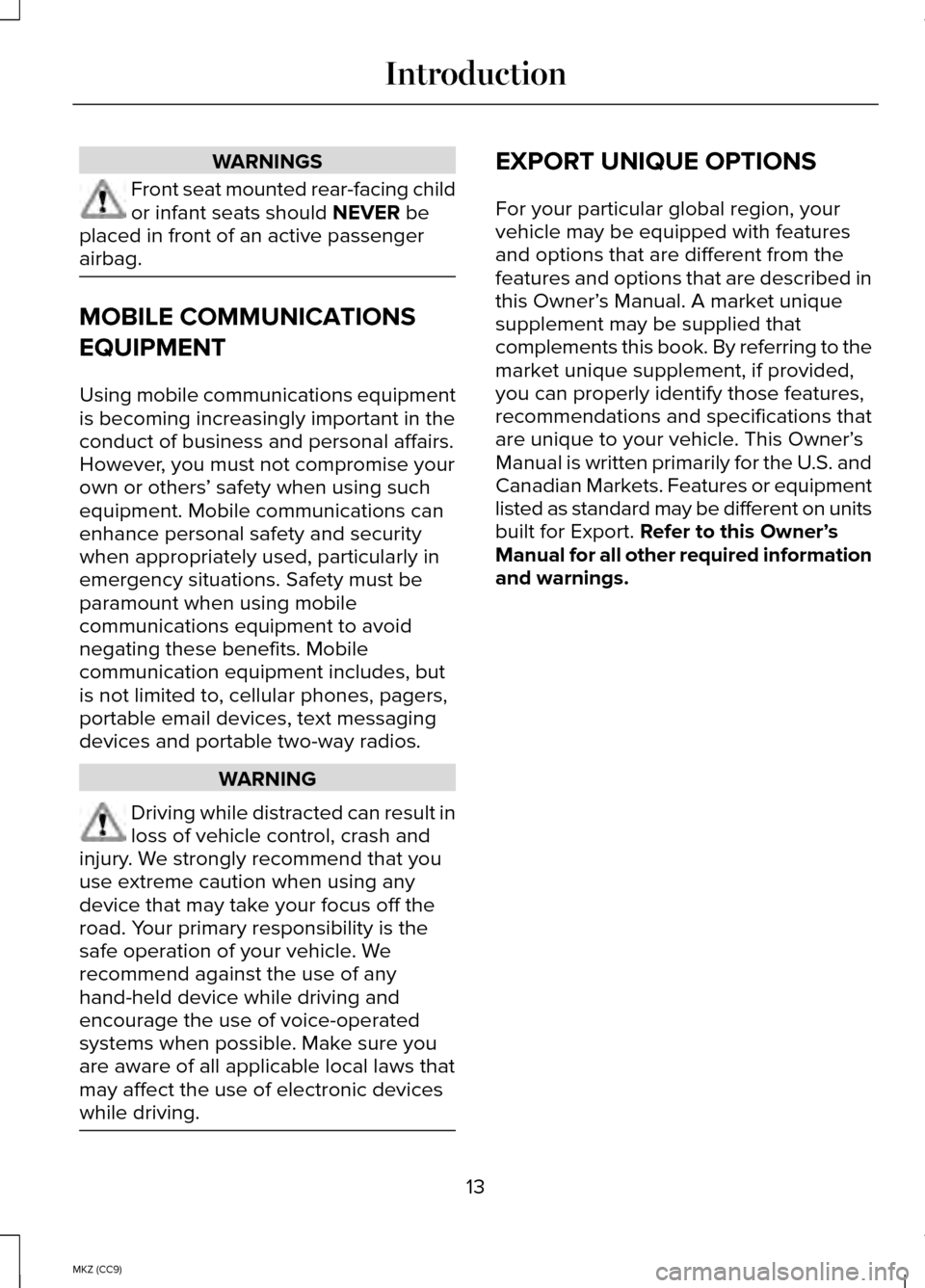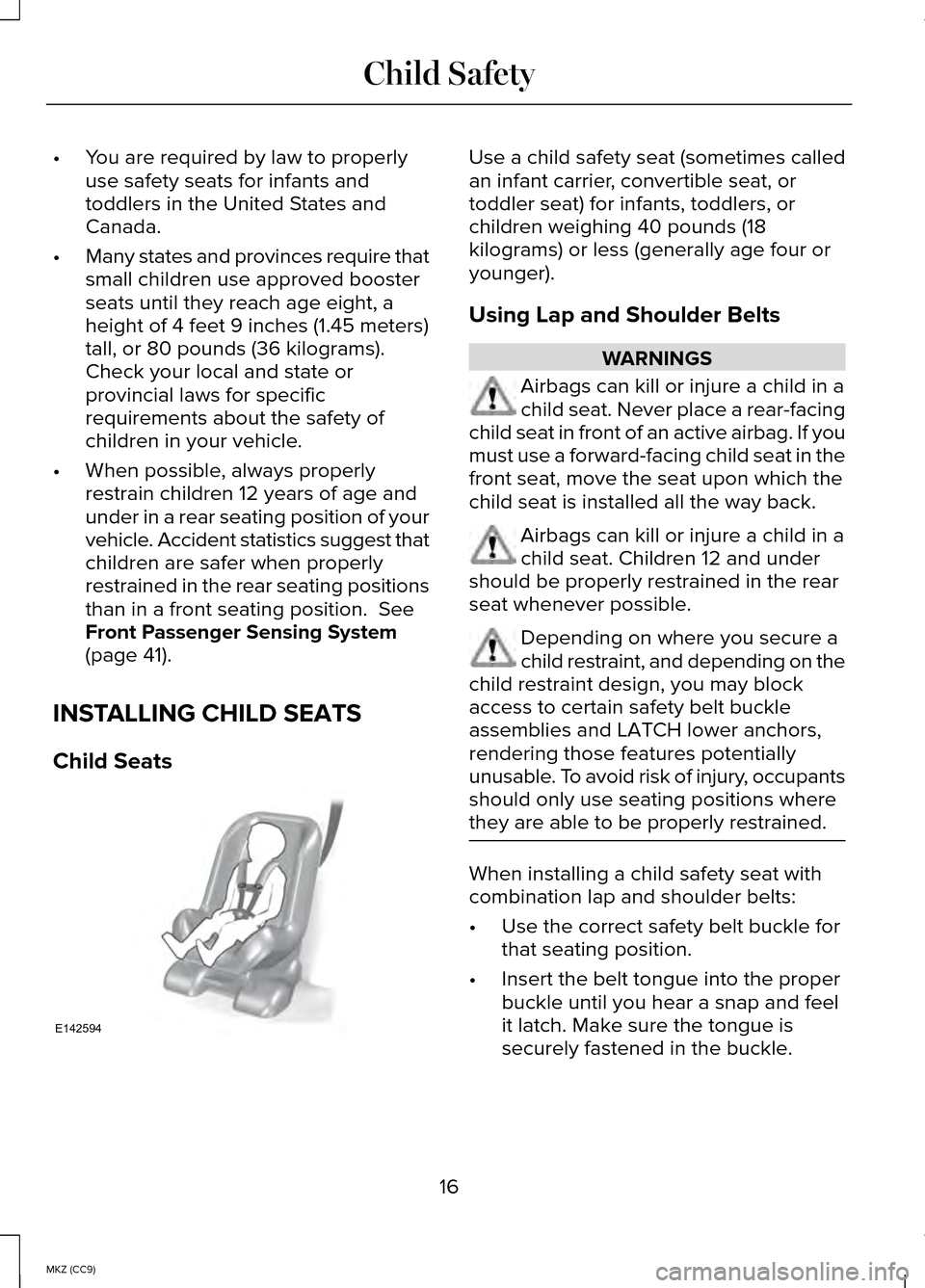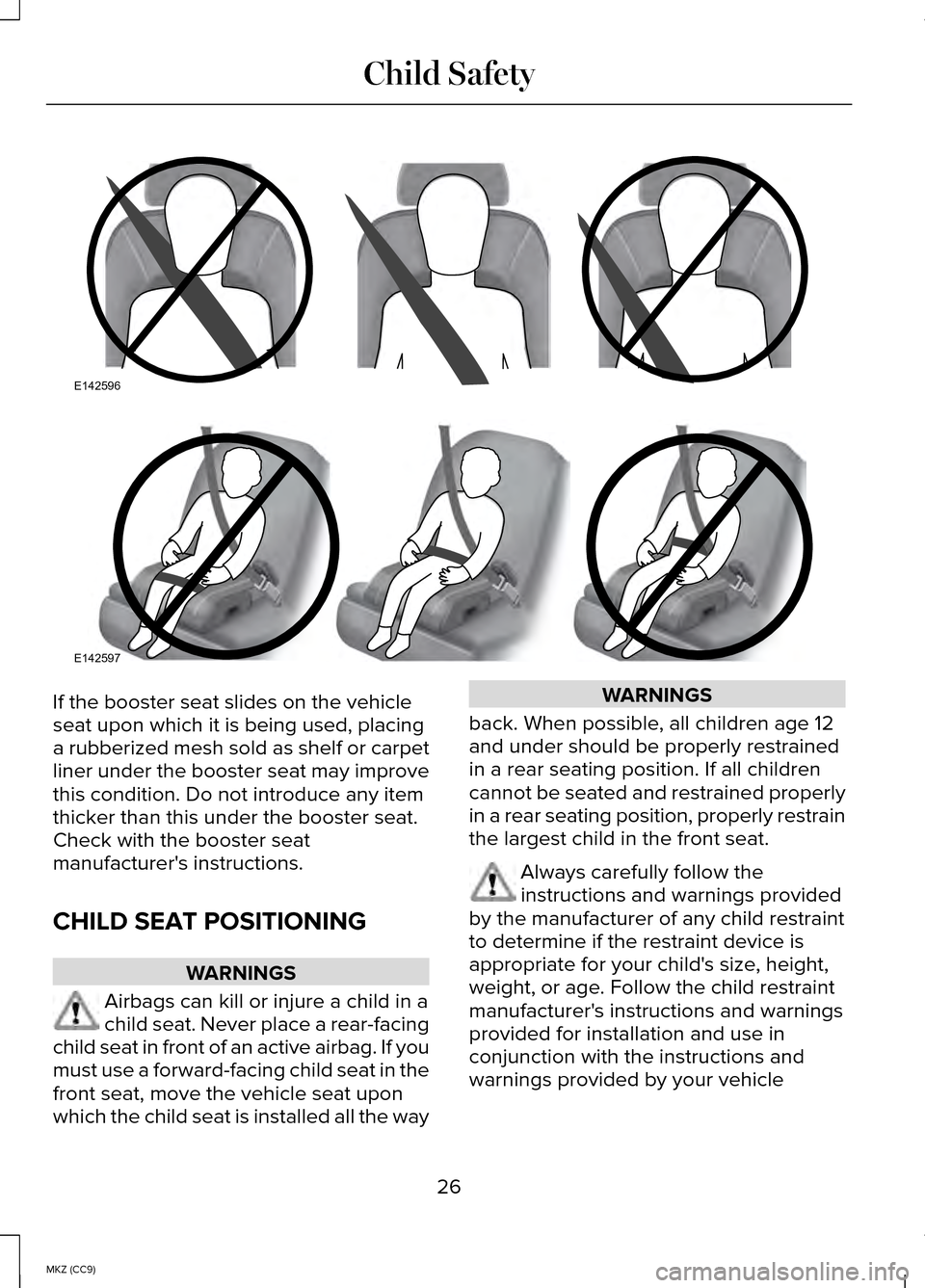2014 LINCOLN MKZ HYBRID airbag
[x] Cancel search: airbagPage 3 of 445

Introduction
About This Manual........................................7
Symbols Glossary..........................................7
Data Recording
..............................................9
California Proposition 65
............................11
Perchlorate
.....................................................11
Lincoln Credit
................................................11
Replacement Parts Recommendation....................................12
Special Notices
............................................12
Mobile Communications Equipment.................................................13
Export Unique Options..............................13
Child Safety
General Information
....................................14
Installing Child Seats
..................................16
Booster Seats
..............................................24
Child Seat Positioning
...............................26
Child Safety Locks.....................................28
Safety Belts
Principle of Operation...............................29
Fastening the Safety Belts.......................30
Safety Belt Height Adjustment................34
Safety Belt Warning Lamp and Indicator Chime........................................................35
Safety Belt Minder
......................................35
Child Restraint and Safety Belt Maintenance............................................37
Personal Safety System ™
Personal Safety System ™
..........................38Supplementary Restraints
System
Principle of Operation...............................39
Driver and Passenger Airbags................40
Front Passenger Sensing System...........41
Side Airbags
.................................................43
Driver Knee Airbag
....................................45
Side Curtain Airbags
..................................45
Crash Sensors and Airbag Indicator....................................................46
Airbag Disposal
...........................................47
Keys and Remote Controls
General Information on Radio Frequencies.............................................48
Remote Control...........................................48
Replacing a Lost Key or Remote Control......................................................52
MyKey™
Principle of Operation
...............................53
Creating a MyKey
.......................................54
Clearing All MyKeys...................................54
Checking MyKey System Status.............55
Using MyKey With Remote Start Systems....................................................55
MyKey Troubleshooting............................55
Locks
Locking and Unlocking.............................58
Keyless Entry...............................................63
Interior Luggage Compartment Release
.....................................................65
Security
Passive Anti-Theft System
........................67
1
MKZ (CC9) Table of Contents
Page 10 of 445

Air conditioning system
Anti-lock braking system
Avoid smoking, flames or sparks
Battery
Battery acid
Brake fluid - non petroleum
based
Brake system
Cabin air filter
Check fuel cap
Child safety door lock or unlock
Child seat lower anchor
Child seat tether anchor
Cruise control
Do not open when hot Engine air filter
Engine coolant
Engine coolant temperature
Engine oil
Explosive gas
Fan warning
Fasten safety belt
Front airbag
Front fog lamps
Fuel pump reset
Fuse compartment
Hazard warning flashers
Heated rear window
Heated windshield
8
MKZ (CC9) IntroductionE162384 E71340 E91392
Page 11 of 445

Interior luggage compartment
release
Jack
Keep out of reach of children
Lighting control
Low tire pressure warning
Maintain correct fluid level
Note operating instructions
Panic alarm
Parking aid
Parking brake
Power steering fluid
Power windows front/rear
Power window lockout
Service engine soon Side airbag
Shield the eyes
Stability control
Windshield wash and wipe
DATA RECORDING
Service Data Recording
Service data recorders in your vehicle are
capable of collecting and storing
diagnostic information about your vehicle.
This potentially includes information about
the performance or status of various
systems and modules in the vehicle, such
as engine, throttle, steering or brake
systems. In order to properly diagnose and
service your vehicle, Ford Motor Company,
Ford of Canada, and service and repair
facilities may access or share among them
vehicle diagnostic information received
through a direct connection to your vehicle
when diagnosing or servicing your vehicle.
Additionally, when your vehicle is in for
service or repair, Ford Motor Company,
Ford of Canada, and service and repair
facilities may access or share among them
data for vehicle improvement purposes.
For U.S. only (if equipped), if you choose
to use the SYNC Vehicle Health Report,
you consent that certain diagnostic
9
MKZ (CC9) Introduction E161353 E139213 E167012
Page 12 of 445

information may also be accessed
electronically by Ford Motor Company and
Ford authorized service facilities, and that
the diagnostic information may be used
for any purpose. See MyLincoln Touch
™
(page 313).
Event Data Recording
This vehicle is equipped with an event
data recorder. The main purpose of an
event data recorder is to record, in
certain crash or near crash-like
situations, such as an airbag deployment
or hitting a road obstacle; this data will
assist in understanding how a vehicle ’s
systems performed. The event data
recorder is designed to record data
related to vehicle dynamics and safety
systems for a short period of time,
typically 30 seconds or less.
The event data recorder in this vehicle is
designed to record such data as:
• How various systems in your vehicle
were operating;
• Whether or not the driver and
passenger safety belts were
buckled/fastened;
• How far (if at all) the driver was
depressing the accelerator and/or the
brake pedal; and
• How fast the vehicle was traveling;
and
• Where the driver was positioning the
steering wheel.
This data can help provide a better
understanding of the circumstances in
which crashes and injuries occur. Note:
Event data recorder data is
recorded by your vehicle only if a
non-trivial crash situation occurs; no data
is recorded by the event data recorder
under normal driving conditions and no
personal data or information (e.g., name,
gender, age, and crash location) is
recorded (see limitations regarding 911
Assist and Traffic, directions and
Information privacy below). However,
parties, such as law enforcement, could
combine the event data recorder data
with the type of personally identifying
data routinely acquired during a crash
investigation.
To read data recorded by an event data
recorder, special equipment is required,
and access to the vehicle or the event
data recorder is needed. In addition to
the vehicle manufacturer, other parties,
such as law enforcement, that have such
special equipment, can read the
information if they have access to the
vehicle or the event data recorder. Ford
Motor Company and Ford of Canada do
not access event data recorder
information without obtaining consent,
unless pursuant to court order or where
required by law enforcement, other
government authorities or other third
parties acting with lawful authority. Other
parties may seek to access the
information independently of Ford Motor
Company and Ford of Canada.
10
MKZ (CC9) Introduction
Page 13 of 445

Note:
Including to the extent that any
law pertaining to Event Data Recorders
applies to SYNC or its features, please
note the following: Once 911 Assist (if
equipped) is enabled (set ON), 911 Assist
may, through any paired and connected
cell phone, disclose to emergency
services that the vehicle has been in a
crash involving the deployment of an
airbag or, in certain vehicles, the
activation of the fuel pump shut-off.
Certain versions or updates to 911 Assist
may also be capable of being used to
electronically or verbally provide to 911
operators the vehicle location (such as
latitude and longitude), and/or other
details about the vehicle or crash or
personal information about the
occupants to assist 911 operators to
provide the most appropriate emergency
services. If you do not want to disclose
this information, do not activate the 911
Assist feature. See MyLincoln Touch™
(page 313).
Additionally, when you connect to Traffic,
Directions and Information (if equipped,
U.S. only), the service uses GPS
technology and advanced vehicle
sensors to collect the vehicle ’s current
location, travel direction, and speed
(“vehicle travel information ”), only to help
provide you with the directions, traffic
reports, or business searches that you
request. If you do not want Ford or its
vendors to receive this information, do
not activate the service. Ford Motor
Company and the vendors it uses to
provide you with this information do not
store your vehicle travel information. For
more information, see Traffic, Directions
and Information, Terms and Conditions.
See
MyLincoln Touch ™ (page 313).CALIFORNIA PROPOSITION 65 WARNING
Some constituents of engine
exhaust, certain vehicle components,
certain fluids contained in vehicles and
certain products of component wear
contain or emit chemicals known to the
State of California to cause cancer and
birth defects or other reproductive harm. PERCHLORATE
Certain components in your vehicle such
as airbag modules, safety belt
pretensioners and remote control batteries
may contain perchlorate material. Special
handling may apply for service or vehicle
end of life disposal. For more information
visit:
Web Address
www.dtsc.ca.gov/hazardouswaste/ perchlorate
LINCOLN CREDIT
Lincoln Automotive Financial Services
offers a full range of financing and lease
plans to help you acquire your vehicle. If
you have financed or leased your vehicle
through Lincoln Automotive Financial
Services, thank you for your business.
For your convenience we offer a number
of ways to contact us, as well as help
manage your account.
Phone: 1-888-498-8801
11
MKZ (CC9) Introduction
Page 15 of 445

WARNINGS
Front seat mounted rear-facing child
or infant seats should NEVER be
placed in front of an active passenger
airbag. MOBILE COMMUNICATIONS
EQUIPMENT
Using mobile communications equipment
is becoming increasingly important in the
conduct of business and personal affairs.
However, you must not compromise your
own or others
’ safety when using such
equipment. Mobile communications can
enhance personal safety and security
when appropriately used, particularly in
emergency situations. Safety must be
paramount when using mobile
communications equipment to avoid
negating these benefits. Mobile
communication equipment includes, but
is not limited to, cellular phones, pagers,
portable email devices, text messaging
devices and portable two-way radios. WARNING
Driving while distracted can result in
loss of vehicle control, crash and
injury. We strongly recommend that you
use extreme caution when using any
device that may take your focus off the
road. Your primary responsibility is the
safe operation of your vehicle. We
recommend against the use of any
hand-held device while driving and
encourage the use of voice-operated
systems when possible. Make sure you
are aware of all applicable local laws that
may affect the use of electronic devices
while driving. EXPORT UNIQUE OPTIONS
For your particular global region, your
vehicle may be equipped with features
and options that are different from the
features and options that are described in
this Owner’
s Manual. A market unique
supplement may be supplied that
complements this book. By referring to the
market unique supplement, if provided,
you can properly identify those features,
recommendations and specifications that
are unique to your vehicle. This Owner’ s
Manual is written primarily for the U.S. and
Canadian Markets. Features or equipment
listed as standard may be different on units
built for Export.
Refer to this Owner’ s
Manual for all other required information
and warnings.
13
MKZ (CC9) Introduction
Page 18 of 445

•
You are required by law to properly
use safety seats for infants and
toddlers in the United States and
Canada.
• Many states and provinces require that
small children use approved booster
seats until they reach age eight, a
height of 4 feet 9 inches (1.45 meters)
tall, or 80 pounds (36 kilograms).
Check your local and state or
provincial laws for specific
requirements about the safety of
children in your vehicle.
• When possible, always properly
restrain children 12 years of age and
under in a rear seating position of your
vehicle. Accident statistics suggest that
children are safer when properly
restrained in the rear seating positions
than in a front seating position. See
Front Passenger Sensing System
(page
41).
INSTALLING CHILD SEATS
Child Seats Use a child safety seat (sometimes called
an infant carrier, convertible seat, or
toddler seat) for infants, toddlers, or
children weighing 40 pounds (18
kilograms) or less (generally age four or
younger).
Using Lap and Shoulder Belts
WARNINGS
Airbags can kill or injure a child in a
child seat. Never place a rear-facing
child seat in front of an active airbag. If you
must use a forward-facing child seat in the
front seat, move the seat upon which the
child seat is installed all the way back. Airbags can kill or injure a child in a
child seat. Children 12 and under
should be properly restrained in the rear
seat whenever possible. Depending on where you secure a
child restraint, and depending on the
child restraint design, you may block
access to certain safety belt buckle
assemblies and LATCH lower anchors,
rendering those features potentially
unusable. To avoid risk of injury, occupants
should only use seating positions where
they are able to be properly restrained. When installing a child safety seat with
combination lap and shoulder belts:
•
Use the correct safety belt buckle for
that seating position.
• Insert the belt tongue into the proper
buckle until you hear a snap and feel
it latch. Make sure the tongue is
securely fastened in the buckle.
16
MKZ (CC9) Child SafetyE142594
Page 28 of 445

If the booster seat slides on the vehicle
seat upon which it is being used, placing
a rubberized mesh sold as shelf or carpet
liner under the booster seat may improve
this condition. Do not introduce any item
thicker than this under the booster seat.
Check with the booster seat
manufacturer's instructions.
CHILD SEAT POSITIONING
WARNINGS
Airbags can kill or injure a child in a
child seat. Never place a rear-facing
child seat in front of an active airbag. If you
must use a forward-facing child seat in the
front seat, move the vehicle seat upon
which the child seat is installed all the way WARNINGS
back. When possible, all children age 12
and under should be properly restrained
in a rear seating position. If all children
cannot be seated and restrained properly
in a rear seating position, properly restrain
the largest child in the front seat. Always carefully follow the
instructions and warnings provided
by the manufacturer of any child restraint
to determine if the restraint device is
appropriate for your child's size, height,
weight, or age. Follow the child restraint
manufacturer's instructions and warnings
provided for installation and use in
conjunction with the instructions and
warnings provided by your vehicle
26
MKZ (CC9) Child SafetyE142596 E142597